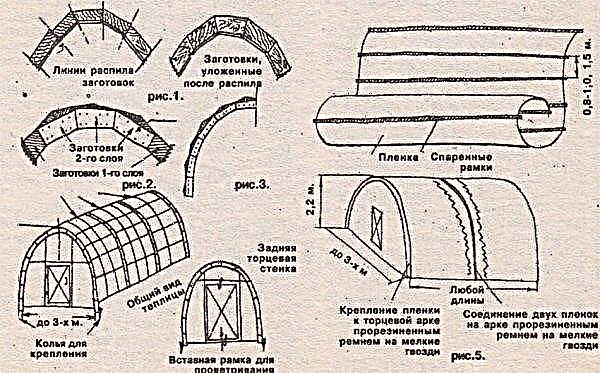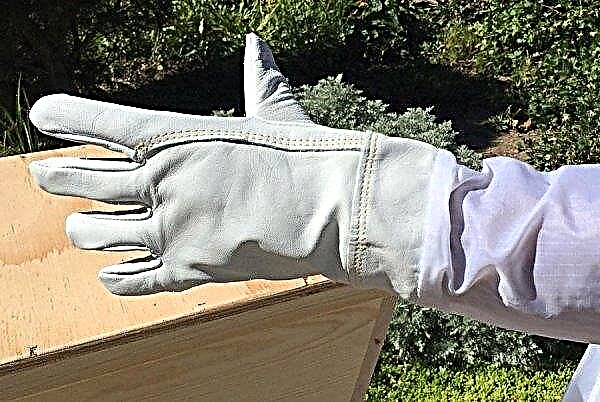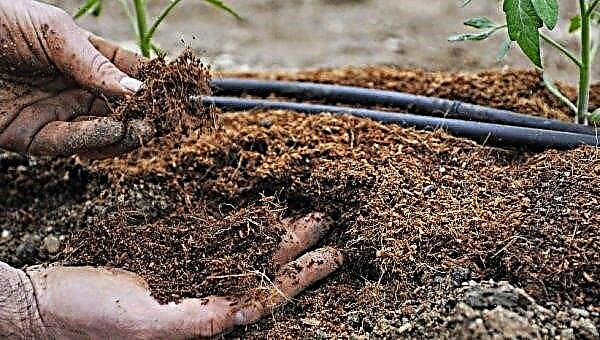Ever since the times of Peter the Great, potatoes have firmly established themselves in the gardens of compatriots. Periodically, thanks to the work of breeders, new, interesting varieties appear. This article will introduce Kolobok potatoes, their characteristics, requirements for cultivation and care.
Description and characteristics of the variety
Potato variety Kolobok was developed as a result of joint work of the All-Russian Research Institute of Agriculture named after A. G. Lorch and the Korenevo agronomic center. A new mid-season variety was included in the Rosreestr for the Central Region in 2005. In just a decade, the variety has gained popularity in Russia and the countries of the former Soviet Union. Kolobok has yellow peel and yellow flesh, a table variety. The bush is medium-sized, standing up to 50 cm.
Did you know? 100 grams of potato contains 75 g of water, 19 g of carbohydrates (15 g of starch and 2.2 g of dietary fiber), 2 g of protein, 0.1 g of fat, vitamins C, E, K, B6 and minerals (magnesium, phosphorus, potassium and others).
Taste qualities
Gingerbread tubers have a good taste, do not darken for a long time on the cut. The starch content in the tubers is 13-15%. In catering, it is used for making french fries and chips.
Ripening period and productivity
Potato Kolobok has an average ripening period and is ready for harvesting in 90–115 days. The variety is fruitful, each bush gives 15–18 tubers of 120–140 g each, in terms of hectare, the yield is 450–600 c / ha.
Advantages and disadvantages of the variety
- pros
- The gingerbread man has a good storage capacity, almost without loss (98%) is transported to other countries.
- the variety is drought tolerant, has good heat resistance.
- little susceptible to diseases such as scab and rhizoctonia.
- Minuses
- It has a low resistance to potato nematode, late blight, and alternariosis.
Planting and growing varieties
To get a good crop of root crops, it is important to consider everything: planting dates, predecessor culture, soil composition, pre-planting preparation and planting pattern.
Did you know? One medium-sized potato contains 110 calories. For example, one serving cup of rice contains 225 calories, and 115 calories in one cup of pasta.
Landing time
In determining the time of planting potatoes, the most important factor is the heating of the soil, so the exact date of the start of planting cannot be called. Depending on the weather, potatoes are planted after the heat has already settled, usually this time falls on the last decade of April or the beginning of May. A prerequisite for planting is heating the soil to + 8 ° C 10-15 cm in depth and the absence of night frosts. According to popular beliefs, the time to plant potatoes came when a penny-sized leaf appears on a birch.
Crop rotation rules
When choosing a place for a potato field, it is necessary to observe crop rotation. It is undesirable to plant potatoes after potatoes, tomatoes, sweet peppers. These crops have common diseases and pests. A potato will succeed if you plant it after cucumbers, beans, beans, cabbage.
Soil requirements
The optimal soil for growing potatoes is chernozem, sandy loam and clay soil. The optimal location of the field is a sunny and open place on a hill. It is undesirable to plant potatoes in lowlands, in such places there is always a risk of developing diseases due to increased soil moisture.
Did you know? One baked potato contains 21% of the recommended daily intake of vitamin B6, 40% vitamin C, 20% potassium and 12% fiber.
Preparing planting material
For planting, it is best to take small tubers, the weight of which does not exceed 70–80 grams. If planting potatoes are too large, then immediately before planting such tubers must be cut into two or more parts. Seed potatoes (whole) immediately after harvesting the previous harvest are placed in boxes or other containers and sent for storage in a dry storage at a temperature of +10 ... + 12 ° C. Spring seed germination begins about a month before the planned planting. Seed tubers are laid out in boxes in two layers so that each tuber has access to light. During germination, the air temperature in the room is around +12 ... + 14 ° C. Before planting in the soil, the sprouts should be well formed, be thick and have a length of about 1 cm. Potato Kolobok should be treated from late blight before planting, for this purpose vegetable growers often use the preparations “Albit” and “Kurzat”.
Seed tubers are laid out in boxes in two layers so that each tuber has access to light. During germination, the air temperature in the room is around +12 ... + 14 ° C. Before planting in the soil, the sprouts should be well formed, be thick and have a length of about 1 cm. Potato Kolobok should be treated from late blight before planting, for this purpose vegetable growers often use the preparations “Albit” and “Kurzat”.
Features of planting potatoes
Planting is carried out in the spring, the optimum temperature for growing this crop is + 20 ° C during the day and about +8 ... + 15 ° C degrees at night. If the planting potato is quite large (more than 200 g), it is cut along so that there are eyes on each lobule, from which stems will later develop.
Did you know? A person can survive on a diet consisting only of potatoes and milk. Milk must be present in food, as potatoes lack vitamin A and D.
Landing technology:
- When planting, potatoes are placed in rows located approximately 60–65 cm apart, and individual bushes in a row are located no closer than 20 cm and no further than 40 cm from each other.
- The furrows in which the potatoes are laid can be created using a shovel, a special manual plow (screaming) or using agricultural machinery (tractor, cultivator, walk-behind tractor).
- After the seed is laid out in rows, it must be covered with a layer of soil with a thickness of at least 10 cm.

Features of potato care after planting
After planting, the care of the potatoes will consist of irrigation, weeding, top dressing and pest control:
- Watering. The need for irrigation is directly dependent on the weather. In dry summer, potatoes should be watered three times a week. Watering begins 20 days after the appearance of the first sprouts above the ground. If it rains a lot, you can not water the field. Moisture is very important for potatoes during the formation of tubers.
- Harrowing. A week after planting, harrowing the field is carried out to limit the growth in the number of weeds. By this time, weed seeds will hatch in the upper soil layer, which will die immediately after harrowing. This procedure is carried out before sunrise, using a light harrow. Before the first potato shoots appear on the soil surface, harrowing can be done several times, which will significantly reduce the number of weeds.
- Weeding. Usually, when weeds are removed, loosening is also carried out, the need for which arises after heavy rainfall, when a crust forms on the surface of the dried soil. Loosening between the rows should be deep (up to 7 cm), in the rows - less deep (up to 3 centimeters) so as not to damage the underground stolons. The first weeding is carried out when the overhead shoots reach 10-14 cm, the second - before the bushes close in the aisles.
- Additional top dressing. During the growing season, two top dressings are carried out. The first - after the appearance of sprouts. Before rain, a nutrient mixture is scattered on the field from equal proportions of superphosphate and ammonium nitrate (2 tbsp. L.) Under each bush. Feeding with rain will fall into the ground. The second top dressing is carried out during flowering, fertilizer is poured under the bush. Composition of top dressing: 1 tbsp. l nitrofoski and 2 tbsp. superphosphate. Spend feeding before flowering potatoes.
- Pest protection. Potatoes must be protected from pests that damage shoots, shoots, bushes and roots, and later tubers. Particularly dangerous pests: wireworm, Colorado potato beetle, potato scoop. Insect repellents can be biological or chemical. The biological method is more economical and safe for people and animals and is based on the fact that the culture is adjacent to plants that repel pests. For example, matthiola, marigolds, wormwood are planted. Also, potatoes are sprayed with infusions of garlic, wormwood. You can use the biological drugs "Actofit", "Bitoxibacillin", "Lepidocide", "Bicol" for these purposes. But insecticides act faster and more efficiently, they must be used carefully and only before tying the tubers.
Important! Berries formed on potato bushes after flowering are extremely toxic to humans.
Pests and diseases of the variety
To get a good crop of root vegetables, the grower must protect the potato field from numerous diseases and pests.
The most common diseases:
- Late blight (Phytophthora infestans). The disease is caused by spores of the fungus, yellowish-green spots appear on the potato leaf in wet weather, which turn black in a short time. On the underside of the leaf, when moving from healthy to dead tissue, there is a grayish-white mycelium, the disease also affects the stem. Lead-gray spots are often visible on diseased tubers, often covering a significant portion of root crops, the affected tuber tissue is brown, the line between the diseased and healthy tissue is liquid. The impetus for the development of the disease is given by a combination of wet weather and temperature from +10 ... + 23 ° C. The spores of the fungus winter in infected root crops, last year's plant debris, in the soil. As preventive measures, it is necessary to avoid monoplanting, to observe the distance in the rows and between plants, to process planting material and vegetative plants with systemic fungicides.

- Potato Alternariosis (Alternaria solani). The disease is provoked by prolonged heat and rain. Usually, the disease appears in June on the oldest leaves, in the form of sharply demarcated, round brown spots with concentric rings of different sizes. In this case, the affected root tissue looks like dry rot. Alternaria infection occurs by contacting potatoes with infected leaves during harvesting. Mushroom spores winter on tubers and on cut tops. Preventive measures: growing less susceptible varieties on dry soil, treatment with fungicides from alternariosis.

- Potato cancer (Synchytrium endobioticum). Fungal disease, usually observed with long-term planting of potatoes in one place, spores persist in the soil for more than 10 years. This is a quarantine disease, further cultivation of root crops on infected soils is prohibited. Tubers affected by potato cancer can be distinguished from healthy potatoes by growths of different shapes and sizes, originating from the eye. Large growths easily break off and often remain in the field, as they are lost during the harvest.
Initially, yellowish-white growths then turn brown, rot and decay. As a preventive measure, apply the quarantine of infected fields, the cultivation of resistant varieties, exclude the use of planting material of unknown origin.

- Potato scab (Helminthosporium solani). In recent years, an increase in this tuberous disease has been observed. On the surface of the peel are silver-brown spots of various sizes, alternating with small black dots (sclerotia). Stains are easier to recognize on washed tubers. Infection increases during storage, especially at high humidity in storage. The pathogen remains viable for up to nine months, it enters the soil with infected planting material. The impetus for the development of the disease is to harvest very ripe potatoes in wet weather, and then store the tubers in warm and high humidity.
Did you know? Potatoes contain more vitamin C than is present in an orange, more potassium than in a banana, and more fiber than in an apple.
Preventive measures: the use of healthy planting material, early harvesting in dry weather. To stop the mushrooms in the development phase, the tubers must be dried quickly after harvesting and then stored in a cool room. Before planting potatoes, they are treated with Prestige, Quadris, Tuberous, Bator or Prestige drugs, and then the sheet is processed with Maxim.

The most common and dangerous pests:
- Scoop - a pest of solanaceous and other garden plants. They are fed on the roots and leaves, after which the plants reduce growth and fade. They live in soil, outwardly look like gray-brown caterpillars up to 4.5 cm long, at night they come to the surface, where the aerial parts of plants are damaged. The scoop does the most damage in June and mid-September. Preventive measures: weed control, in its roots, females scoops love to lay eggs; the winter plowing of the field, thanks to it, pests on the surface of the soil die from frost. Also, Nemabact and Bazudin are used against scoops.

- Colorado beetle - The most common potato pest in many regions of the world. Females leave eggs on the underside of leaves, hatched larvae begin to feed on potato leaves. If you do not take measures, you can completely eat the aerial part of the plant. During the warm period, 2-3 generations of the Colorado potato beetle can develop. The length of the adult beetle is about 10 mm, the wings are yellow with 10 black longitudinal stripes on the first pair of wings and black spots on the head. The body shape is oval and convex. The fight against the Colorado potato beetle requires the use of insecticides. Spraying insecticides (for example, "Karate", "Killer", "Destroy", "Gulliver") in the field is done after the pest larvae hatch on the bushes.

- Wireworm. Wireworm larvae reach a length of 15 to 29 mm, which, combined with the cylindrical shape and bright red color of chitin, makes them look like segments of copper wire. Larvae clog plant tissue, causing its death. In the later stages of potato development, wireworms pose a serious threat to crop quality. The larvae feed on the potato tubers, forming internal passages, which makes it unsuitable for consumption in food, as well as for use as planting material.
Important! There is an effective way to fight Colorado potato beetles without the use of insecticides by pollinating potato fields with basalt powder. Getting on the skin of insects, basalt powder clogs the pores, which leads to their death.
The wireworm is stored in the soil for up to 5 years; its reproduction is facilitated by the absence of crop rotation. In the fight against wireworms, potato growers use such drugs as Prestige, Provotox, Bazudin. In small household plots, you can clear the soil of wireworms, densely sowing marigold seeds on contaminated soil. The next year, the soil will be cleared and potatoes can be planted again.

Harvesting and storage
Harvesting Kolobok begins 95–115 days after planting. To dig root crops, choose a dry and warm day. Harvested roots are sorted out, discarding spoiled and mechanically damaged vegetables, while sorting them by size. Potatoes are well dried before being stored. For food, leave smooth and beautiful potatoes of large and medium size, small root crops are intended for pet food (piglets, goats). For planting next year, medium-sized potatoes are selected, flat, without flaws.
Important! It is necessary to carry out an inspection of the stored potatoes twice a month. If a rotting root crop is found, it must immediately be removed from the store until the rot has spread to neighboring vegetables.
Not later than a month later, table potatoes must be transferred to the basement or cellar with an air temperature of +10 ... + 12 ° C and a humidity of about 82%.Root crops intended for seeds are laid out in the sun and dried for a week. Such seed potatoes acquire a green skin color, this is due to the high content of solanine in the skin and pulp. Green seed potatoes acquire a bitter taste, which does not interfere with reproduction, but will not allow rodents to damage it during storage. To get a good harvest of tubers of the Kolobok variety, the potato grower needs to provide the field with good care: timely watering, loosening, and top dressing. Potato plantations also need reliable protection from pests and diseases.
To get a good harvest of tubers of the Kolobok variety, the potato grower needs to provide the field with good care: timely watering, loosening, and top dressing. Potato plantations also need reliable protection from pests and diseases.



















